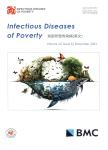Impact of the national hepatitis B immunization program in China:a modeling study
作者机构:School of Public HealthShanghai Institute of Infectious Disease and BiosecurityFudan UniversityShanghaiChina Department of Social MedicineSchool of Public HealthFudan UniversityShanghaiChina 不详
出 版 物:《Infectious Diseases of Poverty》 (贫困所致传染病(英文))
年 卷 期:2022年第11卷第5期
页 面:99-100页
核心收录:
学科分类:1004[医学-公共卫生与预防医学(可授医学、理学学位)] 1002[医学-临床医学] 1001[医学-基础医学(可授医学、理学学位)] 100401[医学-流行病与卫生统计学] 10[医学]
基 金:Shanghai New Three-year Action Plan for Public Health, (GWV-10.1-XK16) Science and Technology Commission of Shanghai Municipality, STCSM, (ZD2021CY001)
主 题:Hepatitis B National immunization program Prevalence Economic analysis Susceptible-ExposedInfectious-Recovered modeling
摘 要:Background:Elimination of hepatitis B virus(HBV)is a striking challenge for countries with high or moderate disease burden.Therefore,using China as a practical case to share experiences for similar countries may accelerate the achievement of the WHO 2030 target of 90%reduction in HBV-related incidence.We aim to evaluate the impact of national HBV immunization strategies in China;and the feasibility to achieve WHO 2030 targets under diferent scenarios.Methods:We constructed an expanded Susceptible-Exposed-Infectious-Recovered(SEIR)model and decision treeMarkov model to estimate the epidemic of HBV in China,assess the feasibility of 2030 Elimination Goals through the projections and conduct the economic analysis.Least square method was used to calibrate the expanded SEIR model by yearly data of laboratory-confrmed HBV cases from 1990 to 2018.Two models were separately used to evaluate the impact and cost-efectiveness of HBV vaccine by comparing prevalence of chronic HBV infections,qualityadjusted life-years(QALYs),incremental cost efectiveness ratio and beneft–cost ratio(BCR)under various intervention options,providing a basis for exploring new containment strategies.Results:Between 1990 and 2020,the number of chronic HBV infections decreased by 33.9%.The current status quo would lead to 55.73 million infections(3.95%prevalence)in 2030,compared to 90.63 million(6.42%prevalence)of the“Without the NIPscenario(NIP:National Immunization Program),114.78 million(8.13%prevalence)without any interventions.The prevention of mother to child transmission(PMTCT)strategy showed a net beneft as 12,283.50 dollars per person,with BCR as 12.66,which is higher than that of universal vaccination at 9.49.Compared with no screening and no vaccination,the PMTCT strategy could save 7726.03 dollars for each QALY increase.Conclusions:Our fndings proved the HBV vaccination has demonstrated a substantial positive impact on controlling the epidemic of HBV in terms of efectiveness and economy after about 30 years of implementation of the national hepatitis B immunization program which also provided containment experience for high or medium burden countries.As for China,the next step should focus on exploring strategies to improve diagnosis and treatment coverage to reduce the burden of HBV-related deaths and ultimately eliminate HBV.



